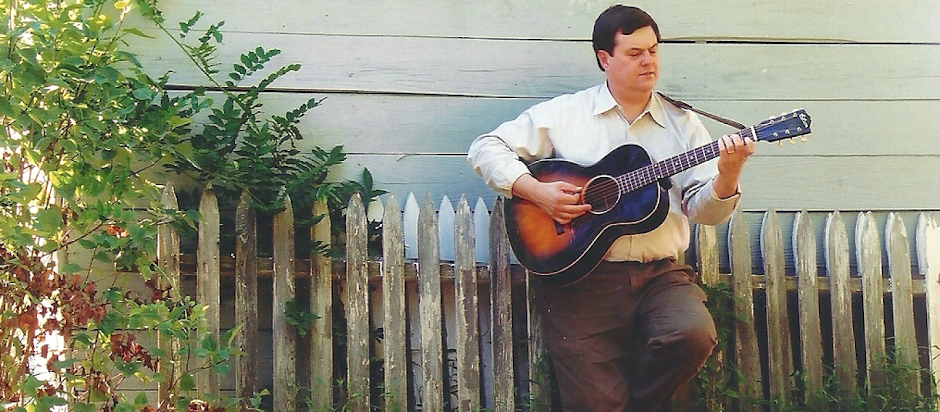 |
| 1938 B&D Groton No. 1 |
The guitar’s raspy-sweet tone was bright, balanced and appealing. Called Groton No. 1, it is an auditorium-size guitar that was built circa 1938 by Regal Co. of Chicago, IL for resale by Bacon Banjo Co. of Groton, CT at $15 retail.
Several years later I found a Bacon catalog from the late 1930s. It described the Groton No. 1 as: "Low in price, plain but beautiful in [its] velvety rubbed finish. Extra large frets, rich tone quality." The same catalog listed a B&D Groton No. 2 with "arched top and back, mahogany, super-auditorium size" at $25 retail. I'll offer details on this big dog at a later time.
 |
| Art Decor headstock on 1938 B & D Groton No. 1 |
Except for the bridge, nut and saddle, it had survived 60 years in original condition, including bridge pins, engraved tuners and two-tone finish. I loved it despite some modest wear, wide neck (17/8-in. nut width) and high action. It just sounds so darn good for jazz and swing tunes, whether comped or flat-picked.
By comparison, ladder-braced, budget-brand guitars such as Gibson's KG-11 from the 1930s have similar body shape, 14-fret neck and sweet-spot bridge location, but shorter 243/4-in. scale length. The B&D's sound board has a larger surface area, more power and heftier sustain than any 141/4-in. wide Kalamazoo. I know this for a fact because I've owned several KG-11 guitars in the last 14 years and compared each to this B&D Groton No. 1.
After a few years it became apparent the Groton's neck angle had to be re-set. In March, 2003, when luthiers Greg Hanson and David Crawford of Raleigh, NC, pulled the neck, they found Popsicle sticks jammed into the neck's dovetail joint. By removing them, trimming the dovetail edge and re-glueing the joint, they re-established a proper fit of the neck to the body of the guitar. And once the mass of the neck had rejoined the mass of the body, the whole instrument thrummed with delight.
A few years after I bought it Jeff Kline, the guitar store owner, told me this guitar once graced the walls of Izzy Young's Folklore Center in NYC's Greenwich Village in the 1960s. Whenever the folk-singing crowd visited Young's store without their own guitar, they'd pull this Groton off the wall and play it. So, in addition a jazz-era pedigree and sound, this guitar has folk-era provenance.
Still, buying and playing a vintage guitar, even a cheap one like my Groton, proved an experience of dubious value even as it opened many doors for me. I became a player who collected guitars, someone who visited vintage instrument dealers, spent hours online shopping for vintage models, and compared the appointments, sound and cost of older instruments.
Over the next 14 years I investigated the vintage guitar market and learned how to deal with guitar dealers. I bought and sold about 140 vintage instruments (some at a profit, many at a loss), repaired dozens of guitars, and documented the provenance of numerous guitars. And because I performed Vintage Music Concerts at retirement villages, I was given ten instruments by the original owner, his widow, his daughter or the executor of his estate.
So the B&D Groton ultimately opened many doors for me. But, as my wife once remarked, it also led me down the path to ruin.
______________________________________
© 2011 Kenneth Lelen - All Rights Reserved

No comments:
Post a Comment